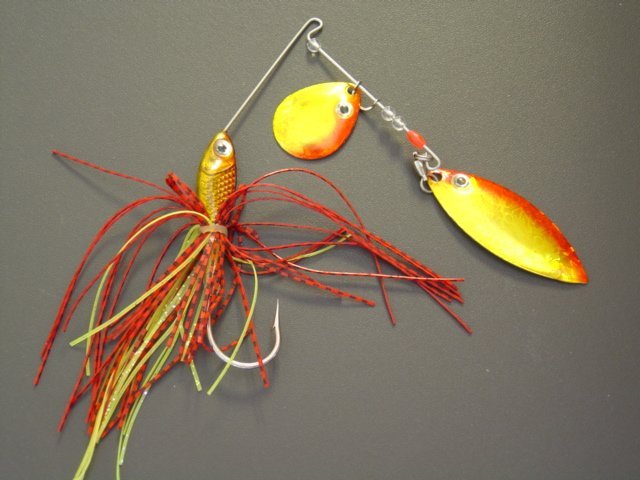
The spinnerbait has been around for a long time. Crafted in the early 20th Century, The Shannon Twin Spinner, which was produced by a former company in Chicago, Illinois was known to be a very versatile lure by catching bass both shallow and deep with modifications to the blade size and head weight. The Shannon design is still around today with some companies producing a modified version of the Twin Spinner.
During the 1970's decade, the spinnerbait became very popular. Many professional bass tournaments were won with spinnerbaits. Rick Clunn, Tommy Martin, and Jimmy Houston, to name a few, gained fame by tossing spinnerbaits to shoreline cover. This popularity has lead to the many innovative designs that we have available for us today.
A spinnerbait is made up of a bent wire that holds a spinner or a blade over a lead body. Paint, colorful skirts, and sometimes rattles are added to make the spinnerbait more attractive to bass. There are basically three types of spinnerbaits. 1) the Single spin. 2) the Tandem spin, and 3) the Twin spin. While each of these three types of spinnerbaits each have their own advantages and disadvantages, the Tandem spin type is, in my opinion, the most versatile of the 3 types and my personal favorite.
Spinnerbaits come in all sizes (1/8oz. - 1oz.), shapes, and colors, as do the spinner blades. How do you choose the right spinnerbait? Let's keep this as simple as possible. If you fish in clear water most of the time use a smaller lure with smaller blades. If you fish in water that is colored or stained use a bigger lure with bigger blades. Another determining factor is the season. Switch the size with the season. Use smaller lures in the spring. Use bigger lures in the fall. The most common sizes are 1/4, 3/8, and 1/2 ounce. The 3/8 oz. size is the most versatile and I use this size most of the time. I will go to 1/2 oz. if it is windy. I try to pick spinnerbaits that have medium sized, willow leaf blades. I primarily use only two colors depending on the time of day, white/chartreuse during daylight, and black in low light conditions.
Although spinnerbaits probably do not resemble a natural food source, the combination of vibration, flash, and profile as the lure is pulled through the water make it attractive to bass. The spinnerbait is one of the most versatile bass fishing lures available. You can fish them shallow, deep, and anywhere in between. If you do not have a few spinnerbaits in your arsenal, than I would recommend getting one or two and give them a try. Oh, and one other thing, not only do bass like them, but pike like 'em too. Be ready.
I have been bass fishing for over 25 years, and I have been fortunate enough to go bass fishing on some of the best bass fishing lakes in the midwest and southeast like Lake Eerie, Lake St. Clair, Grand Traverse Bay, Douglas Lake, Lake Jocassee, and Lake Norman to name a few. However, most of my fishing is done on the small lakes, rivers, and ponds of northeastern Indiana.
For more information on the top bass fishing lures , or if you would like to cast your vote for the best bass fishing lure. click here
If you would like some information on a great place to fish for smallmouth bass.
(Article Source: http://EzineArticles.com/?expert=Gregory_Jackson)

